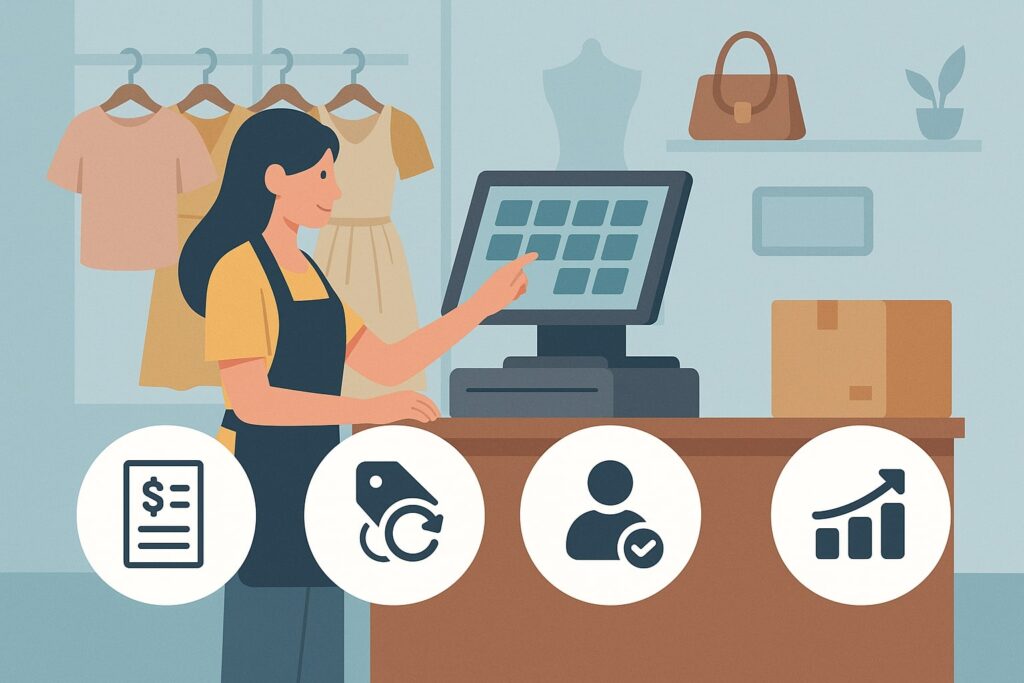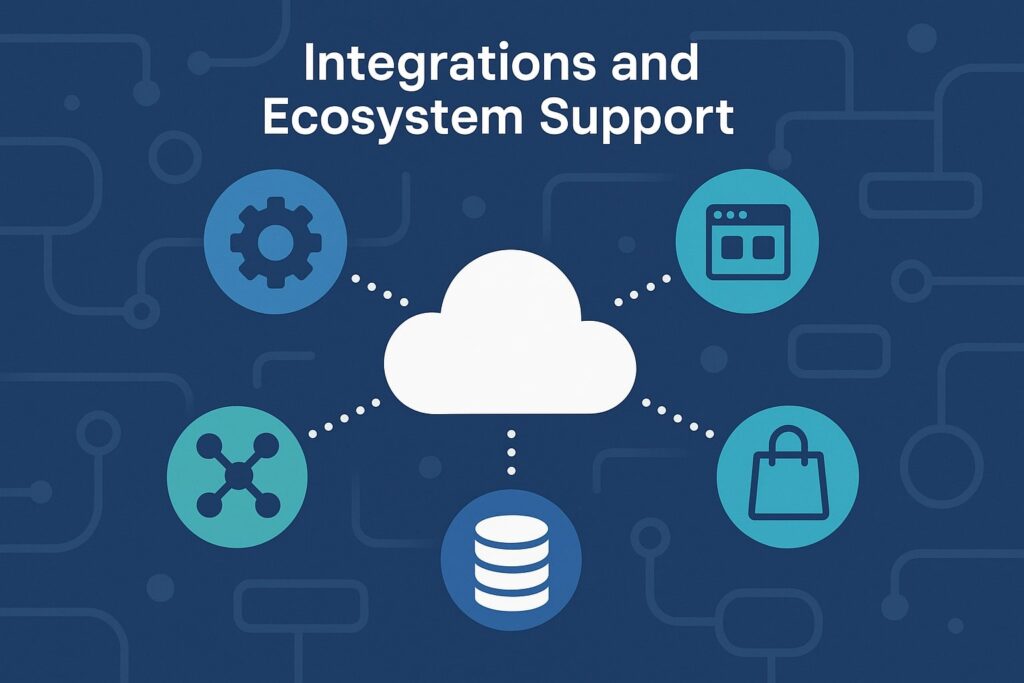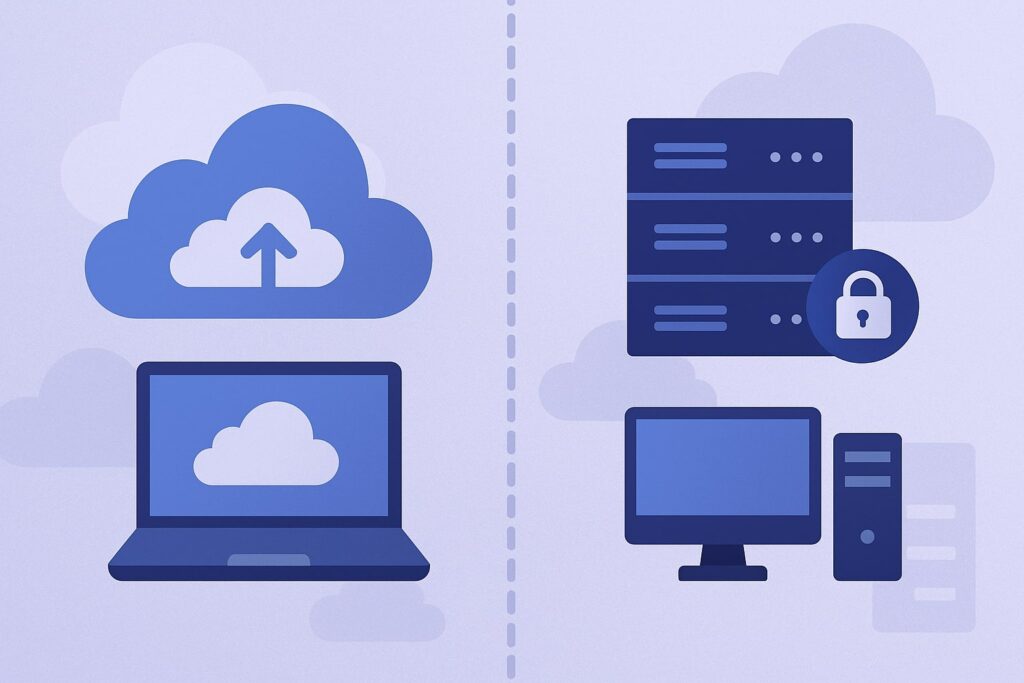
By consignmentpos September 13, 2025
Choosing the right point-of-sale (POS) system is crucial for consignment and resale store owners. A consignment POS is specifically designed to handle the unique needs of stores that sell items on behalf of others.
It tracks each item by its original owner, manages consignor payouts, and generates detailed reports to help you run your business more efficiently. Modern cloud-based POS solutions also improve customer service, increase efficiency, and let you access your sales data from anywhere.
A consignment-focused POS differs from a regular retail POS because consignment shops do not buy inventory outright – they hold items for others and pay them a share when the item sells.
As a result, consignment stores need software that can link each unique item to its consignor until sold, automatically split payments, and manage consignor accounts. Using a generic POS often requires error-prone workarounds (like treating each consignor as a vendor), so a dedicated consignment system is recommended once your inventory grows.
Key Features to Look For in Consignment POS

When evaluating consignment POS options, focus on features that support inventory control, consignor management, and multi-channel sales. Important features include:
- Unique inventory tracking: Consignment POS must tag and track each individual item separately. The system should link every product to its consignor and update inventory in real time as items are added or sold. Look for barcode scanning, batch tagging, and multi-location stock control.
- Consignor/vendor management: You need tools to manage consignor accounts, contracts, and payouts. Good software provides a consignor portal or login so sellers can view their inventory and earnings. It should handle vendor ID scanning and keep detailed consignor profiles.
- Automated commissions and payouts: The POS should automatically calculate the store’s commission versus the consignor’s share on each sale. This split-payment capability and schedule of payouts saves time and prevents errors. Look for features that let you set flat-rate or percentage-based consignor commissions.
- Sales reporting & analytics: Detailed, customizable reports are critical. The system should generate sales reports by item, category, or consignor, as well as inventory aging and profitability analytics. These reports help you see which consignors or products perform best and make data-driven business decisions.
- Multi-channel / e-commerce integration: Since many consignment shops sell both in-store and online, seamless integration with e-commerce platforms is important. The software should sync inventory and sales across all channels. For example, integrations with Shopify or Square Online keep your web store inventory up to date in real time.
- Customer management (CRM): A built-in CRM or loyalty program can boost repeat business. Look for features that store customer profiles, track purchase history, and support promotions or loyalty points. Even simple features like emailing receipts or marketing integrations (Mailchimp, etc.) can improve engagement.
- Flexible payment processing: The POS must accept various payment methods (credit/debit cards, mobile wallets, gift cards, cash, etc.) and process split tender for consignor transactions. Transparent transaction fees and multiple processor options are a plus.
- Cloud-based and mobile support: A modern consignment POS should be cloud-hosted so you can access data from any device. Cloud systems offer automatic updates, data security, and anywhere-access. Make sure the software runs on tablets or smartphones and supports multiple registers.
- Multi-location capability: If you have (or plan) multiple store locations, choose software that centralizes inventory, sales, and consignor data across all sites. This ensures you can transfer stock between stores and manage everything from one dashboard.
| Feature | Why It Matters for Consignment |
|---|
| Unique item tracking | Links each product to its consignor; essential for payouts. |
| Consignor management & portal | Simplifies communication and payouts; maintains consignor records. |
| Automated payout calculations | Automatically splits sales into store profit and consignor share. |
| Multichannel/E-commerce sync | Keeps in-store and online inventory and sales data consistent. |
| Detailed reporting | Tracks sales trends and consignor performance for informed decisions. |
| CRM and loyalty | Helps retain customers with profiles, history, and rewards. |
| Flexible payment processing | Accepts various payments and ensures transparent fees for sales. |
| Cloud & mobile access | Remote access, automatic backups, and ease of use on tablets/phones. |
Integrations and Ecosystem Support

A consignment POS that integrates well with other tools can greatly streamline your operations. Key integrations to consider include:
- E-commerce platforms: Look for built-in or add-on integrations with online storefronts (Shopify, WooCommerce, Magento, etc.).
These keep your consignment inventory synced across your website and physical store, so you don’t oversell and always have up-to-date stock data. Some systems offer real-time Shopify or Square Online sync via certified partnerships. - Accounting software: Integration with accounting/ERP systems (QuickBooks, Xero, etc.) automates financial data entry.
Sales, expenses, and consignor payouts can post directly into your books, reducing manual work. For example, Square’s marketplace and others often provide apps to sync with QuickBooks or Xero for consignment businesses. - Payment gateways and hardware: Ensure the POS works with your preferred payment processor (Square, Stripe, PayPal, etc.) and hardware (card readers, receipt printers, barcode scanners).
Cloud POS vendors usually support standard devices, so you can use tablets, iPads, and USB/Bluetooth peripherals. - Email/CRM tools: Integrations with email marketing or CRM tools (like Mailchimp or Constant Contact) allow you to send newsletters, sales alerts, and order confirmations directly from your POS data.
Square, Shopify and others have app ecosystems where you can connect loyalty programs, SMS marketing, or CRM services to your consignment data. - Shipping and fulfillment: If you ship items (especially for online consignment sales), look for shipping integrations (ShipStation, Sendle, etc.) that can print labels and track orders from within the POS.
This is especially useful if your consignment items are sold through marketplaces or your own site. - Consignor portals: Some consignment systems integrate with a private seller portal (or offer it natively). This lets consignors log in online to see their unsold items, recent sales, and payment history. It can improve transparency and reduce the administrative burden of reporting to consignors.
Overall, versatility is key. Choose a POS ecosystem that lets you add modules or third-party apps as needed. For example, a Square or Shopify-based setup can tap into dozens of apps for everything from gift cards to inventory forecasting.
As one expert notes, combining a general POS with dedicated consignment software gives you a modern checkout experience and “ensures you’re still managing the unique consignment workflows (like allowing consignors to log into a portal to see their item statuses)”.
Always verify that any consignment management software you consider has reliable, real-time integrations with your chosen POS and other systems.
Cloud vs. On-Premise Deployment

Nearly all new consignment POS solutions are cloud-based, which brings several benefits. Cloud POS stores your data on secure remote servers, so you can access sales and inventory from any internet-connected device.
This means you can monitor your store from home or on the go, and add new registers without installing software. Cloud systems also receive automatic updates and backups – you don’t have to manually install patches or worry about losing data if a computer crashes.
By contrast, an on-premises or legacy POS (installed on a store computer) ties you to that hardware and often requires separate licensing fees for updates. Many experts point out that modern cloud solutions offer lower total cost of ownership and greater flexibility.
For example, cloud POS providers generally handle security and data backups for you, so your business is protected by enterprise-level measures. They also regularly roll out new features and improvements at no extra cost, keeping your system up to date with retail trends.
In short, a cloud-based consignment POS will let you “do less technical work, maintenance” and will keep you on the cutting edge without large upfront expenses.
It also enables easier scalability: you can add new stores or users quickly and pay on a subscription basis. Consider cloud options first, unless you have a specific reason for on-site systems.
Hardware and Support
Modern consignment POS systems are designed to run on common devices. Check that the software works on the platforms you use – typically iPads, Android tablets, or Windows PCs. Essential hardware includes: a card reader to accept credit/debit cards; a tablet or smartphone for the cashier interface; and a label or receipt printer.
For example, many stores use a label printer to print barcode tags with price and consignor ID for incoming items. A barcode scanner can speed up high-volume inventory entry. Because cloud systems are hardware-agnostic, you’re free to choose any compatible equipment and upgrade later.
Don’t forget support and training when choosing software. A good vendor will offer onboarding, training videos, and responsive tech support to help you set up consignor profiles, import existing inventory, and customize settings.
Look for providers with positive user reviews on customer service (TechnologyAdvice and Merchant Maverick often mention user experience ratings). Free trials and demos can help you test usability before committing.
Since your staff will use the system daily, ease of use is paramount – fortunately, cloud POS solutions tend to have modern, intuitive interfaces thanks to regular updates.
Comparing Costs and Value
Consignment POS solutions come in different pricing tiers. Many operate on monthly subscription plans (some specialize and others as add-ons to general POS).
For example, one dedicated consignment POS charges around $159/month with online store integration as an add-on, whereas general POS systems may start from free or low monthly fees (often charging more for premium plans or hardware).
Beyond the software fee, consider transaction costs (credit card processing), hardware purchases (like tablets or printers), and any setup fees.
Beware of proprietary systems that lock you into high fees or single payment providers. As Circle-Hand analysts note, legacy consignment systems often force you to use their preferred processor (sometimes with higher swipe fees) and proprietary hardware, driving up costs.
By contrast, a flexible POS system (such as Square or Shopify) usually lets you choose among many payment processors at competitive rates. One expert concludes that a modern POS + consignment app combo “often isn’t locked in” and provides the same capabilities at a much better price point.
In summary, balance cost against functionality. A cheaper system may lack critical features (leading to manual work later), while a very expensive one may offer more than you need. Always calculate the total cost of ownership over a year or two.
Factor in software fees, hardware, and the time saved by automation. Sometimes paying a bit more per month is worthwhile if the system saves you hours of admin work and grows with your business.
Frequently Asked Questions
Q.1: What is consignment POS software?
Answer: It’s a point-of-sale system built for resale and consignment shops. It tracks inventory items by consignor, calculates store commissions versus consignor shares, and automates payouts. In short, it handles the unique workflows of consignment businesses.
Q.2: Why can’t I use a regular POS for consignment?
Answer: Generic retail POS can’t natively link each sale to a consignor or automatically split the sale amount. Workarounds (treating consignors as “vendors” or manually tracking items) become error-prone as your inventory grows.
A dedicated consignment POS ensures every item is tied to its owner and automates the calculations and reporting you need.
Q.3: What key features should I look for?
Answer: Look for inventory control and consignor management. For example, the POS should let you tag items with consignor IDs, scan barcodes, and receive automated alerts. It should manage consignor profiles, contracts, and payments, ideally with an online portal.
Other must-haves include detailed sales and inventory reports, integration with your payment and e-commerce systems, and multi-store support.
Q.4: Can Square or Shopify POS handle consignment sales?
Answer: Yes, to an extent. These platforms have powerful checkout features, and you can add consignment functionality via third-party apps. For example, Square POS can integrate with Rose or Circle-Hand consignment apps.
These setups let Square handle payments while consignor tracking is done in the integrated software. However, out of the box they won’t automatically split sales by consignor – you’ll need an add-on that syncs in real time.
Q.5: How important is cloud/mobile access?
Answer: Very important. A cloud-based POS means your sales and inventory data lives online, so you (and your team) can access it anywhere on any device. Cloud POS systems also auto-update and back up your data.
Modern consignment systems support iPads, tablets, and phones, so you can make sales on the shop floor or add new items using a mobile device.
Q.6: What hardware do I need for a consignment POS?
Answer: Typically, you need a tablet or smartphone to run the POS app, a card reader to accept payments, and receipt or label printers. For consignment, a label printer is handy to print price tags with barcodes and consignor IDs.
You may also use a barcode scanner for high-volume inventory entry. Most cloud-based POS allow using any compatible standard device, so you’re not locked into expensive proprietary hardware.
Q.7: How do I know the system will grow with my business?
Answer: Look for a solution with unlimited users/devices and robust multi-location support. Check the vendor’s pricing plans – can you upgrade to a higher tier or add locations easily?
Good consignment POS are designed to scale, handling more consignors and items as you expand. Reading user reviews can help gauge whether a system remains reliable at higher volumes.
Conclusion
Finding the right consignment POS system means matching features to your store’s workflow. Ensure the software can manage unique inventory items, track consignor data, and automate payouts – these are essential for any consignment operation.
Also verify that it integrates with your online store, accounting tools, and hardware, so your entire business ecosystem works together. Opt for a cloud-based, mobile-friendly solution for maximum flexibility and access.
Finally, compare pricing plans and support options to pick a system that fits your budget and growth plans. Taking the time to assess these factors will help you choose a POS that streamlines your operations and keeps consignors and customers happy.